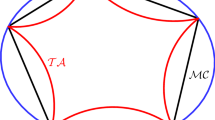Abstract
We present a preprocessing algorithm to make certain polynomial time algorithms strongly polynomial time. The running time of some of the known combinatorial optimization algorithms depends on the size of the objective functionw. Our preprocessing algorithm replacesw by an integral valued-w whose size is polynomially bounded in the size of the combinatorial structure and which yields the same set of optimal solutions asw.
As applications we show how existing polynomial time algorithms for finding the maximum weight clique in a perfect graph and for the minimum cost submodular flow problem can be made strongly polynomial.
Further we apply the preprocessing technique to make H. W. Lenstra’s and R. Kannan’s Integer Linear Programming algorithms run in polynomial space. This also reduces the number of arithmetic operations used.
The method relies on simultaneous Diophantine approximation.
Similar content being viewed by others
References
R. E. Bixby, O. M.-C. Marcotte andL. E. Trotter, Jr., Packing and covering with integral flows in integral supply-demand networks,Report No. 84327—OR, Institut für Ökonometrie und Operations Research, University Bonn, Bonn, West Germany.
J. W. S. Cassels,An Introduction to the Theory of Numbers, Berlin, Heidelberg, New York, Springer, 1971.
W. H. Cunningham, Testing membership in matroid polyhedra,Journal of Combinatorial Theory B,36 (1984), 161–188.
W. H. Cunningham andA. Frank, A primal dual algorithm for submodular flows,Mathematics of Operations Research.,10 (1985).
E. A. Dinits, Algorithm for solution of a problem of maximum flow in a network with power estimation,Soviet Math. Dokl.,11 (1970), 1277–1280.
J. Edmonds, Minimum partition of a matroid into independent subsets,Research of the Nat. Bureau of Standards 69 B (1965), 67–72.
J. Edmonds, System of distinct representatives and linear algebra,J. Res. Nat. Bur. Standards,71 B (1967), 241–245.
J. Edmonds andR. Giles, A min-max relation for submodular functions on graphs,Annals of Discrete Mathematics,1 (1977), 185–204.
J. Edmonds andR. M. Karp, Theoretical improvements in the algorithmic efficiency for network flow problems,J. ACM,19 (1972), 248–264.
S. Fujishige, A capacity rounding algorithm for the minimum-cost circulation problem: a dual framework of the Tardos algorithm,Mathematical Programming,35 (1986), 298–309.
Z. Galil andÉ. Tardos, AnO(n 2(m+n logn)·logn) minimum cost flow algorithm,in: Proc., 27th Annual Symposium on Foundations of Computer Science (1986), 1–9.
M. Grötschel, L. Lovász andA. Schrijver, The ellipsoid method and its consequences in combinatorial optimization.Combinatorica,1 (1981), 169–197.
M. Grötschel, L. Lovász andA. Schrijver,The ellipsoid method and combinatorial optimization, Springer Verlag,to appear.
R. Kannan, Improved algorithms for integer programming and related lattice problems,in: Proc.,15 th Annual ACM Symposium on the Theory of Computing (1983), 193–206.Final version: Minkowski’s Convex Body Theorem and Integer Programming, Carnegie-Mellon University,Report No. 86–105.
A. K. Lenstra, H. W. Lenstra, Jr. andL. Lovász, Factoring polynomials with rational coefficients,Math. Ann.,261 (1982), 515–534.
H. W. Lenstra, Jr., Integer programming with a fixed number of variables,Math. of Operations Research,8 (1983), 538–548.
É. Tardos, A strongly polynomial minimum cost circulation algorithm,Combinatorica,5 (1985), 247–255.
É. Tardos, A strongly polynomial algorithm to solve combinatorial linear programs,Operations Research, (1986), No. 2
U. Zimmermann, Minimization of submodular flows,Discrete Applied Math.,4 (1982), 303–323.
Author information
Authors and Affiliations
Additional information
This research was done while the authors were visiting the Institute for Operations Research, University of Bonn, West Germany (1984–85), and while the second author was visiting MSRI, Berkeley. Her research was supported in part by NSF Grant 8120790.
Rights and permissions
About this article
Cite this article
Frank, A., Tardos, É. An application of simultaneous diophantine approximation in combinatorial optimization. Combinatorica 7, 49–65 (1987). https://doi.org/10.1007/BF02579200
Received:
Revised:
Issue Date:
DOI: https://doi.org/10.1007/BF02579200




